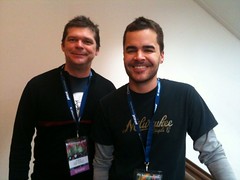 Eric Wicks and I meet each other periodically at events like SXSW and FITC. He’s an Austin-based artist, designer, strategist, and fellow cyclist. Earlier this week, I tweeted his Designing Bicycle Cities post. We share similar big bike ideas and agree on the need to return to simplicity on the web. Last year Eric wrote about about design challenges
Eric Wicks and I meet each other periodically at events like SXSW and FITC. He’s an Austin-based artist, designer, strategist, and fellow cyclist. Earlier this week, I tweeted his Designing Bicycle Cities post. We share similar big bike ideas and agree on the need to return to simplicity on the web. Last year Eric wrote about about design challenges
For a solution to be truly sustainable and good it must have a positive return to the environment and society. At the heart of any design problem is a question: Are we trying to make something less bad or are we trying to make things better?
and makes his case for better problem solving with the bicycle and the example of the Copenhagen Wheel
As somebody who regularly commutes by bike I can say that the benefits are wide and far-reaching and impact everything from the finer details of my budget to the core of my fitness.
But there’s also another, less tangible benefit to biking: It reduces the barrier between the rider and the environment. Every time I get on my bike–whether it’s a ride to work or distance over the weekend–I look around at some point and truly notice something about my surroundings.
Copenhagen Wheel Slide from the Design the Ordinary: Mix Version
In other words, besides racing, commuting, Tweed-riding, or whatever, the bike is a connector to people and the world around them. David Byrne wrote a book about that and the reason wherever I travel, I take a bike with me and meet cyclists on the road like Eric and all y’alls.
…We're riding townies, adventure, and mountain bikes. Find recommendations on our store page. As Amazon Associates we earn from qualifying purchases.
